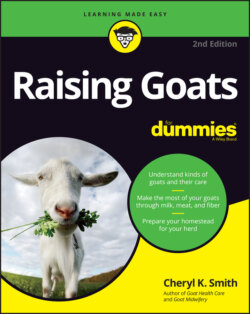Читать книгу Raising Goats For Dummies - Cheryl K. Smith - Страница 83
Angora
ОглавлениеAngoras have long, wavy coats, with fiber called mohair. (Angora fiber comes from rabbits.) They are usually white, but some breeders are experimenting with producing other colors. Their horns can be long or short and are curved or spiral, in the case of bucks. They are usually left on the goat, because they may regulate body temperature. The average adult goat produces 8 to 16 pounds of mohair each year, while kids give from 3 to 5 pounds of longer, finer hair. Figure 3-8 shows an Angora buck.
FIGURE 3-8: An Angora buck.
Angora goats came from Turkey, and their name is derived from the city of Ankara, which used to be called Angora. These goats were first brought to the United States in 1849. Since then their popularity has grown, so that now the United States is one of the biggest producers of mohair. Most of the producers are in Texas.
If you’re wondering whether anyone has tried crossing Angoras with cashmeres, the answer is yes. But the resulting goats — called Cashgoras — were a bit of a flop, producing fiber that isn’t as useful or as high-quality as the original products.
Angoras may be raised on a range, but in that case a couple of problems arise. They are sensitive to temperature and cold, and wet weather can kill them. They also are not natural mothers and so they sometimes abandon their kids. The kids often need help to get started nursing. And with twins and triplets, the bigger kids hog all the milk if not controlled, leaving the little ones nothing to eat.
